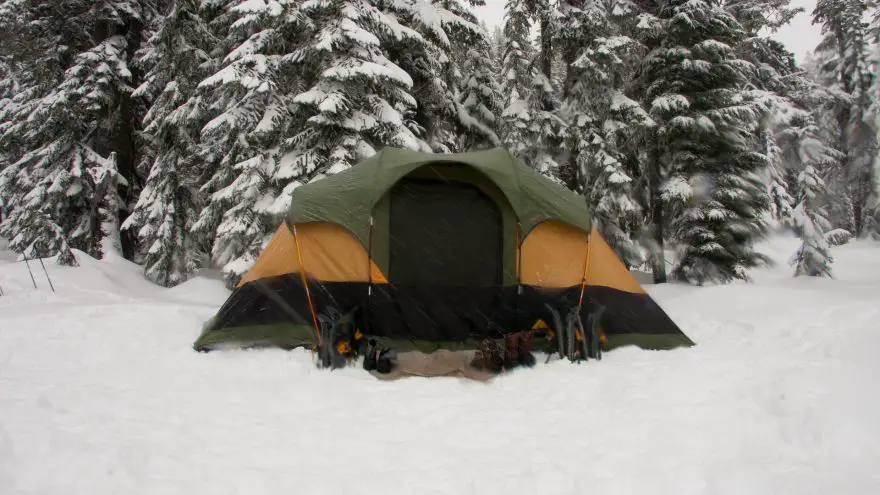How to Heat a Tent?
 How to Heat a Tent?
gearweare.net
How to Heat a Tent?
gearweare.net
Winter is approaching but that doesn’t mean it’s time to stop camping. With the proper setup camping, every month of the year is not only feasible but can be quite comfortable. Still, sometimes the temperatures drop so low that even the highest quality zero-degree sleeping bag, insulated blankets, and your favorite pair of winter socks won’t keep you warm. On these chilly nights, you may want to heat your camping tent some other way. There are many ways to warm up a tent, and although they all come with some danger, when the proper precautions are taken it can be done quite safely.
Table of Contents
Preparing for the Procedure
Placing a small heater inside the tent is the most obvious way to get it warm. Electric heaters are the safest option, but they do require electric hookups which are often only available at RV camp sites. However, staying in an RV site is not ideal when tent camping. These heaters can also be hooked up to a small power generator or an inverter connected to your car battery. Either way though, this is a lot of extra equipment you need to bring with you and set up, even when car camping. If you do think an electric heater is right for you though, some great brands include Pelonis, DeLonghi, Lasko and Holmes.
However, if you want to know how to heat a tent without electricity, you could invest in propane heaters. These heaters are easier to use in a tent, although they do emit CO2 and are therefore more dangerous than electric heaters. With proper ventilation, which most tents have built into them, the release of carbon into your tent should not be a problem. If you are still worried, open the vestibule while the heater is running. This will release some of the heat, but will also ensure that the air is pure.
There are a few propane heaters on the market that are specifically made for Coleman tents and others, most made by Coleman and Mr. Heater. All these heaters are catalytic, meaning they produce heat without a flame. If this is how you choose to heat your tent, never run the heater while you sleep. Instead, turn it on an hour to a half-hour before you go to bed so it warms the tent, turn it off when you enter the tent, and, if necessary, turn it on again when you wake in the morning.
Warming the Tent with Candle Lanterns
If you are wondering how to heat a tent with a candle, we have a perfect solution for you. Candle lanterns can be another effective way to heat your tent. Without the hassle of an electric heater and the dangers of propane, these contraptions use an open flame within the glass to provide light, and, as long as it’s not extremely cold or windy, it can increase the temperature in your tent by 10 to 15 degrees. Of course, this is an open flame and therefore must be handled with care. Never fall asleep with a candle lantern-lit, but rather use the same method you would with a propane heater – carefully put it in the tent sometime before you intend to go to bed. Your tent should warm and cozy by the time you enter, at which point you should immediately blow the candle out.
If you’re looking for something a bit lower-maintenance, chemical heat packs are an excellent option for warming up your sleeping bag. These come in two types: single-use and reusable. Single-use heat packs last 10 to 15 hours depending on their size. After they cool down though they cannot be used again and should be thrown away. Reusable heat packs can be reactivated by placing them boiling water for about 10 minutes. Whichever style you choose to use, place the heat pack in your sleeping bag 15 to 30 minutes before you plan to go to bed, and when you get in there yourself it will be toasty warm. A warning, heat packs can cause skin irritation to some people.
All of the options outlined above are great if you know that it’s going to be a freezing night. Sometimes though, the cold can catch us by surprise. If you find that you need to heat your tent but do not have any of the equipment to do so, fear not, there are still ways to get the job done.
On cold nights having a fire is an integral part of camping. The fire can also be the key to heating your tent. Find a few rocks that you can easily carry and place them on the fire. Once they are glowing, carefully remove them with tongs or a very thick pair of leather gloves. Place them to the side until the cooldown enough that they are easy to handle and wrap them in a camping towel, then place the wrapped rocks inside your tent. Be very careful that none of the rock touch the tent material, as this will instantly burn a hole.
Lighting a Fire on a Sandy Surface
If you are camping in a sandy area and have a bit more time, place 15 to 20 rocks on the fire and while you are waiting for them to heat up dig a hole about a foot deep. Once the rocks are up to temperature, place them in the hole and bury them in the sand. Place your tent on the dirt above this hole and it will be heated via the flow for most of the night. Making sure the hole is the correct depth is very important, because if not the rocks could burn it. Sand is also crucial, as it allows the heat to rise more easily than dirt.
Finally, if you need to heat your tent in a pinch, the boiling water in a Nalgene trick works great. Place the heat-filled water bottle at the base of your sleeping bag and it will keep you warm for hours. Be careful to shut it tightly though, since leaked water can cause severe burns.
Fear of the cold is a common reason why people stop camping in the winter. However, by utilizing any one of these methods guarantees you’ll stay warm all night no matter the temperature. Figure out which one works best for you and you’ll soon be a pro at camping during any month of the year.











